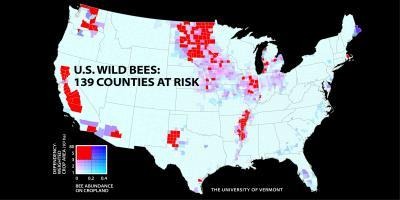Dwindling Bee Numbers Put Crucial U.S. Crops At Risk
Bee populations are changing and decreasing in many places around the world, and studies indicate that humans are largely to blame. According to a new national bee-mapping study, which for the first time looks into wild bee populations across the States, the nation's crucial crops are at risk of destabilization due to the drastic reduction in bee populations.
The new report finds that bee populations in some of the U.S's most important farming counties are decreasing, including in many regions in California, areas of the Pacific Northwest and SW states, and, mostly, in the Midwest. The research was conducted by University of Vermont's Insu Koh and team; they found that 39-percent of the nation's croplands rely on pollinators, and that from 2008 to 2013 the number of wild bees dropped 23-percent.

This study, in essence, shows the hotspots where bee populations are both vital and on the downswing. A total of 139 counties located within "key agricultural" areas have both growing demand for crop pollination and dwindling wild bee populations. The type of crops affected include pumpkins, peaches, watermelons, plums, almonds, apples, berries, and similar. Other counties affected grow very large amounts of crops that are less dependent on pollinators, including soybeans and cotton.
In addition to climate change, increased demand for corn crops are cited as one cause of decreasing wild bee numbers. As corn demand increases (particularly for creating biofuels), more states till larger parcels of land for growing corn, eradicating the pastures bees need to survive. Check out the timeline below for other bee-related news!
SOURCE: EurekAlert
